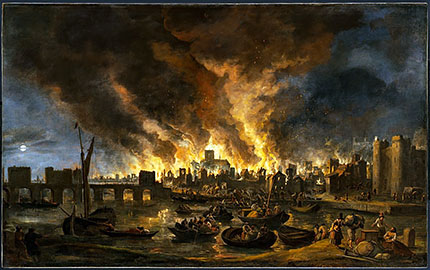

The Great Fire of
London began on the night of September 2, 1666, as a small fire on
Pudding Lane, in the bakeshop of Thomas Farynor, baker to King Charles II.
At one o'clock in the morning, a servant woke to find the house
aflame, and the baker and his family escaped, but a fear-struck maid
perished in the blaze.
At this time, most London houses were of wood and pitch construction, dangerously flammable, and it did not take long for the fire to expand. The fire leapt to the hay and feed piles on the yard of the Star Inn at Fish Street Hill, and spread to the Inn. The strong wind that blew that night sent sparks that next ignited the Church of St. Margaret, and then spread to Thames Street, with its riverside warehouses and wharves filled with food for the flames: hemp, oil, tallow, hay, timber, coal and spirits along with other combustibles. The citizen firefighting brigades had little success in containing the fire with their buckets of water from the river. By eight o'clock in the morning, the fire had spread halfway across London Bridge. The only thing that stopped the fire from spreading to Southwark, on the other side of the river, was the gap that had been caused by the fire of 1633.
The standard procedure to stop a fire from spreading had always been to destroy the houses on the path of the flames, creating “fire-breaks”, to deprive a fire from fuel. Lord Mayor Bludworth, however, was hesitant, worrying about the cost of rebuilding. By the time a Royal command came down, carried by Samuel Pepys, the fire was too out of control to stop. The Trained Bands of London were called in to demolish houses by gunpowder, but often the rubble was too much to be cleared before the fire was at hand, and only eased the fire's way onward. The fire blazed unchecked for another three days, until it halted near Temple Church. Then, it suddenly sprang to life again, continuing towards Westminster. The Duke of York (later King James II) had the presence of mind to order the Paper House demolished to create a fire break, and the fire finally died down.
At this time, most London houses were of wood and pitch construction, dangerously flammable, and it did not take long for the fire to expand. The fire leapt to the hay and feed piles on the yard of the Star Inn at Fish Street Hill, and spread to the Inn. The strong wind that blew that night sent sparks that next ignited the Church of St. Margaret, and then spread to Thames Street, with its riverside warehouses and wharves filled with food for the flames: hemp, oil, tallow, hay, timber, coal and spirits along with other combustibles. The citizen firefighting brigades had little success in containing the fire with their buckets of water from the river. By eight o'clock in the morning, the fire had spread halfway across London Bridge. The only thing that stopped the fire from spreading to Southwark, on the other side of the river, was the gap that had been caused by the fire of 1633.
The standard procedure to stop a fire from spreading had always been to destroy the houses on the path of the flames, creating “fire-breaks”, to deprive a fire from fuel. Lord Mayor Bludworth, however, was hesitant, worrying about the cost of rebuilding. By the time a Royal command came down, carried by Samuel Pepys, the fire was too out of control to stop. The Trained Bands of London were called in to demolish houses by gunpowder, but often the rubble was too much to be cleared before the fire was at hand, and only eased the fire's way onward. The fire blazed unchecked for another three days, until it halted near Temple Church. Then, it suddenly sprang to life again, continuing towards Westminster. The Duke of York (later King James II) had the presence of mind to order the Paper House demolished to create a fire break, and the fire finally died down.
Although
the loss of life was minimal (some sources say only sixteen perished),
the magnitude of the property loss was staggering. Some 430 acres, as
much as 80% of the city proper was destroyed, including 13,000 houses,
89 churches, and 52 Guild Halls. Thousands of citizens found themselves
homeless and
financially ruined. The Great Fire, and the fire of 1676, which
destroyed over 600 houses south of the river, changed the face of London
forever. The one positive effect of the Great Fire of London was that
the plague, which had ravished London since 1665, diminished greatly,
due to the mass death of the plague-carrying rats in the blaze.
No comments:
Post a Comment